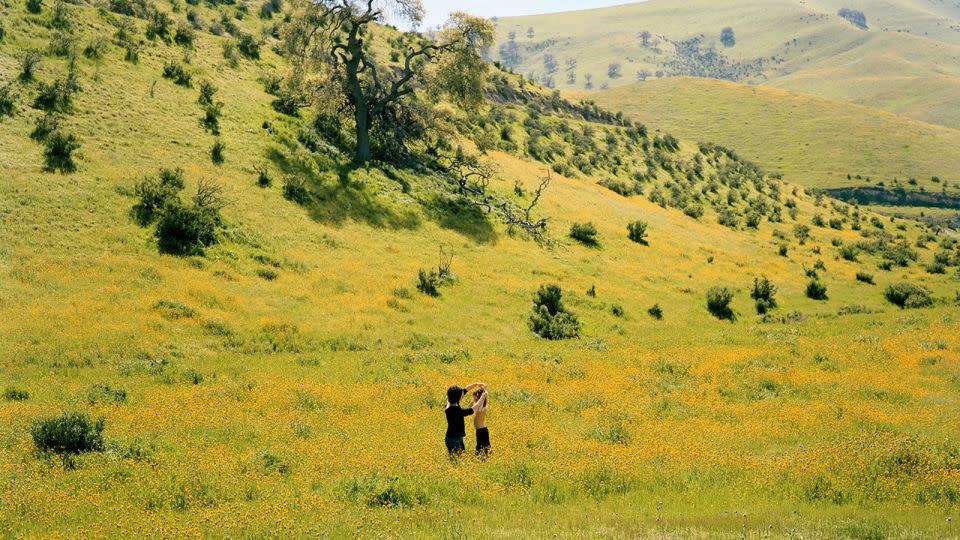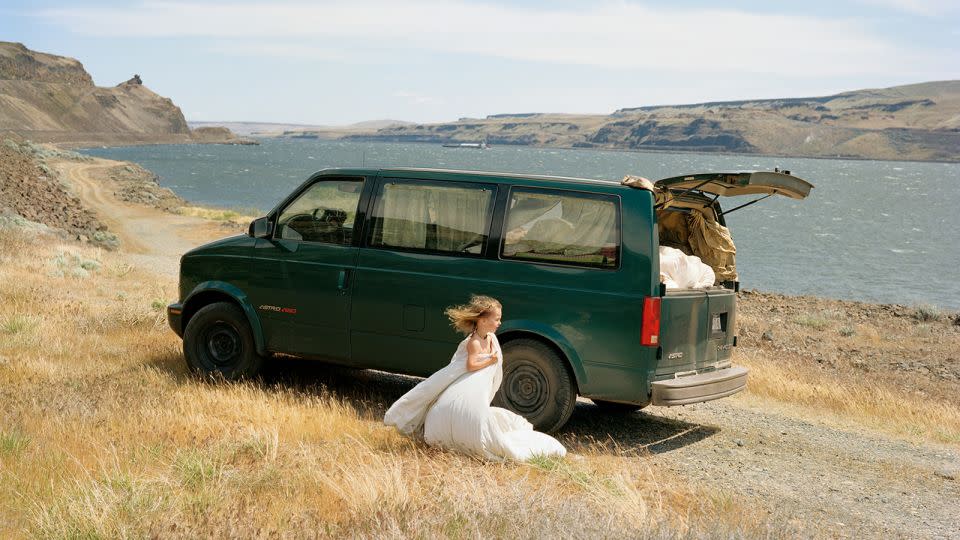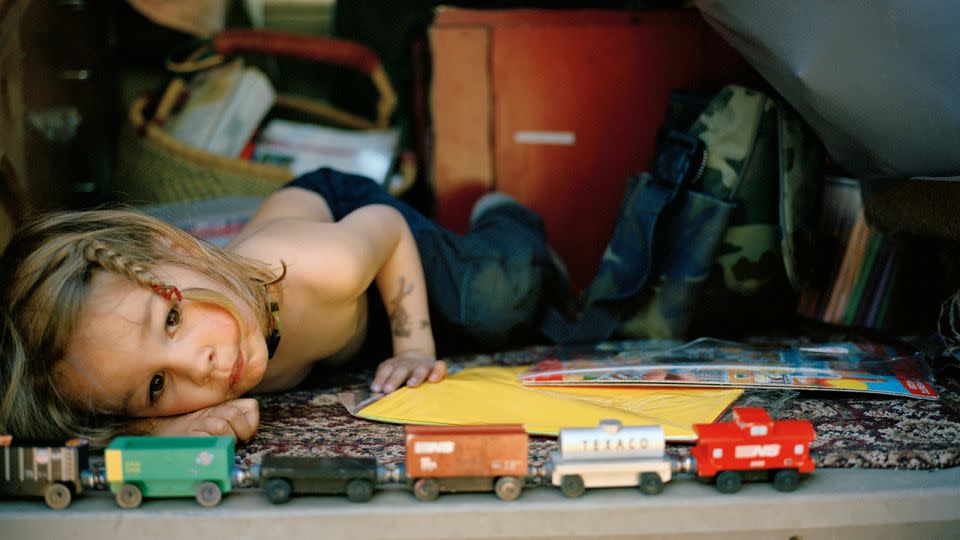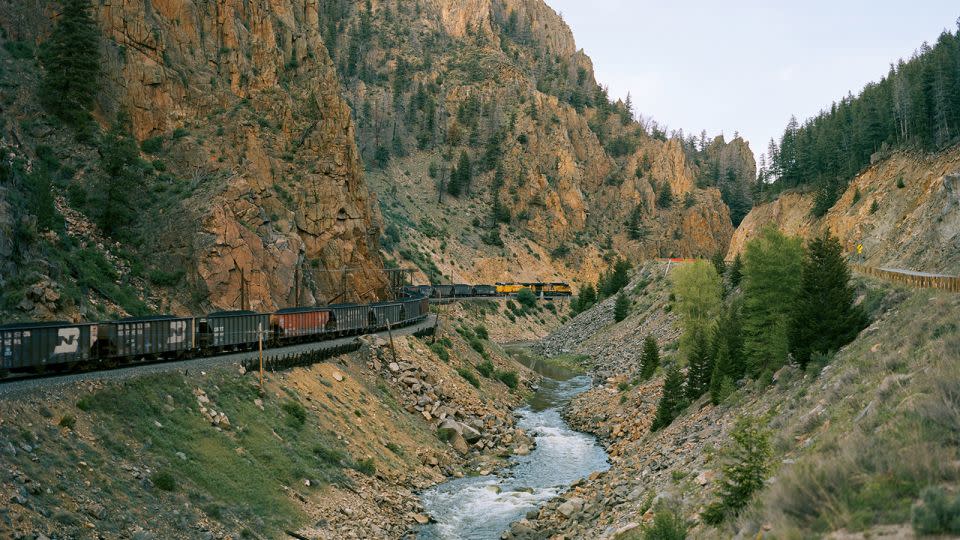A photographer and her son spent six years traveling the American West
- Oops!Something went wrong.Please try again later.
In Justine Kurland’s photographs, shot across the American West, trains silently pass through the picture plane: Burnt red and yellow railroad cars emerge from tree-lined curves, bisect flat plains and disappear into the mouths of tunnels; weathered freight cars yoked together both dot the terrain and demarcate it. The images are inherently steeped in history — the bloody, relentless westward expansion of a nascent country and, today, the vast but aging infrastructure of a world power.
But, from 2005-2011, the locomotives also represented a negotiation between Kurland and her young child, Casper, as he joined her on the road for up to eight months of the year from the time he was a baby. Living out of a van and a camping tent in parks and rural stopovers, Casper became fascinated by the rumbling approach of each train’s procession. He often led her to the scenes in her photos, Kurland told CNN. In her images, his hair is often windblown, his gaze fixed on the blurred passing cars.
“Casper loved trains, and if I was going to schlep him on these road trips, it made sense that I would then incorporate trains into the photographs that I was making,” she said in a video call with CNN.

For a long time, Kurland didn’t show the work she had made as they traveled together, except for a handful of images of Casper in “Highway Kind,” her 2016 book that pieced together multiple bodies of work she had shot on the road to better understand American mythologies.
Across her three-decade career, Kurland has frequently photographed people on the fringes of society, staging scenes of runaway girls and documenting communes, transient lifestyles and spiritual experiences. But she’d never shown portraits of herself, and for a long time the idea of presenting an entire monograph on her son seemed too “sentimental,” she explained.
Though even at the time, she knew there “something significant enough about our life on the road that I needed to document,” Kurland noted, “I just hid those photos away.”
A nomadic family portrait
In the years since, however, Kurland has gained perspective on the resonance of their images and journeys together. It is rare to think of a traditional family unit as a nomadic mother and child, and rarer, still, to make family images that don’t sit in nostalgia, or mark all the little triumphs of boyhood. Kurland and Casper are, instead, often solitary figures, even together, with their own inner lives. They set out West in a tradition mythologized by men, from explorers to photographers and writers.
“What’s important in thinking about these pictures… is to (consider) what a family album could look like, that doesn’t look like the way we think of motherhood,” she said.


The photos that make up “This Train,” newly-published by Mack Books, are presented as a duality. In the book, accordion-style pages pull out, following the pair’s life on the road: On one side, Kurland prepares a meal at a fold-out table while Casper looks out over the firepit; Casper holds a hollowed lost tooth in palm of his hand. On the reverse, the series of trains weave in and out of the American landscape. Some were taken by Casper, in fact, clicking the shutter for his mom, as he and Kurland discussed in a conversation published in Aperture in 2016.
“Sometimes we would wait so long,” Kurland told him of their patience for trains to appear. “Sometimes we would wait all day.”
Embedded histories
Kurland calls the book “a love letter to Casper,” who is now 19 years old, but also “an acknowledgement that his life wasn’t so easy.” Though for years he thought his life was normal — that other mothers at highway rest stops were photographers with their kids, too — he had a hard time adjusting to school when she enrolled him as a six-year-old, she said.
“There’s certain kinds of ideas of normalcy (in) family life that, when you divert… it makes things significantly more complicated,” Kurland said.


Living off irregular paychecks, Kurland and Casper would sometimes have to “hunker down” at campsites until a deposit came through.
“There were really harrowing times on the road… we’d have to sleep in a garage, and I was making macaroni and cheese on a Bunsen burner for Casper because we had to wait until the mechanic had fixed my 10-year-old van with like 250,000 miles on it,” she said.
In 2008, when the recession hit, Kurland took a teaching job that provided a steadier income, and reduced her road trips to summer and winter breaks. Casper’s father had become more involved in his life by that point, she noted — and after he turned 11, Casper asked to stop traveling entirely.
As “This Train” details, as much as the book is about their relationship, there’s other darker narratives implicit in Kurland’s images. The rail system symbolizes the markings of colonial settlers on the land — the forced migration and demise of Indigenous populations, as well as the deaths of some 1,200 Chinese immigrants who laid the tracks, the latter of which the scholar Lily Cho addresses in an essay for the book. In that way, Kurland’s reverse images of lone trains have a spectral presence, tracing and retracing the same pathways of the dead who built them.
“If I’m pointing my camera at the trains because Casper loves them, I’m still also pointing at the history embedded in the landscape of those trains,” Kurland said. Fifteen years later, she explained, she looks at the images from a more “critical distance,” she explained, one that deeply considers the landscapes’ significance in US history.
Her interpretations — and those of viewers — will likely keep shifting, she acknowledges, just like any other photograph seen by different people over a period of time. “The thing that’s beautiful about every photograph is that they get to change,” she said. “They don’t have fixed meaning; no photograph does.”
For more CNN news and newsletters create an account at CNN.com

